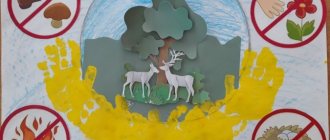Development of a lesson on ecology Subject, object, tasks and methods of environmental science.
Development of lessons on ecology
Sevastopol
Lesson #1
| Group |
| date |
Subject.
Subject, object, tasks and methods of environmental science.
Lesson objectives:
Educational:
expand students’ knowledge about ecology as a complex, complex, multifaceted science about the relationships between living and inanimate nature, about tactics and strategies for the conservation and balanced development of life on Earth; form an idea of the subject, object, tasks and methods of natural science;
Developmental:
develop logical thinking and creative abilities of students; justify the need for a minimum of environmental knowledge for modern people;
Educational:
cultivate a responsible attitude towards nature, increase interest in the study of ecology, cultivate a sense of pride in nature;
Methodical:
development of moral environmental thinking skills.
Equipment and materials:
diagrams, tables, printed materials.
Basic concepts and terms:
ecology, autecology, synecology, demecology, biosphereology, biocenology, monitoring, modeling, forecasting, cartography, theoretical ecology, applied ecology.
Lesson type:
learning new material, applying knowledge, skills and abilities.
Lesson type:
lesson-dialogue.
Lesson methods:
interactive, explanatory and illustrative - conversation, story; reproductive, partially searching, problematic, creative.
Interdisciplinary connections:
geography, biology, law
Expected results:
after this lesson, students will be able to define ecology as a complex, complex, multifaceted science about the relationships between living and inanimate nature; name the subject, object and tasks of environmental science; name and characterize the methods of environmental science; analyze the complex structure of ecology; compare the main directions of ecology; determine the place of ecology in the system of sciences.
Lesson structure
I. Organizational stage. . . . . . . . . .. . . . 1 min
II. Motivation for learning activities. . . . 1 min
III. Learning new material. . . . . . . . 25 min
IV. Generalization and systematization of knowledge 15 min
V. Lesson summary. . . . . . . . . . . . . . . . . . . . . . . 2 minutes
VI. Homework . . . . . . . . . . . . . . .. . . 1 min
During the classes
I.
Organizational stage
Welcoming students, checking their readiness for the lesson. The teacher explains the requirements for workbooks, notebooks for practical work, recommends textbooks and teaching aids.
II.
Motivation for educational activities
Shrouded in a thin blue veil of the atmosphere, like a precious diamond, the beautiful planet Earth shines against the backdrop of the black vacuum of space. The time has come for everyone to realize that we live in a ghostly ozone space, that our Earth is a unique heavenly flower.
And we destroy this flower, destroy its shell, tear out the tender sprouts of the forests. Birds and animals, flowers and trees turn to man:
“Keep where you stand, where you live, at a distance of sight and voice, at least at the distance of an outstretched hand.” It is necessary to introduce into our lives such concepts as “ecological thinking” and “ecological work”. A new category of rights should be developed - the rights of Nature!
III
.
Studying new material
1. Subject, object, tasks and methods of environmental science
The term “ecology” (“oikos” - house, “logos” - science) was introduced by the famous German zoologist E. Haeckel in 1866 in his work “General Morphology of Organisms”. The term “ecology” and its derivatives (ecological situation, polluted environment, etc.) have now become widely used not only in the scientific literature, but also in a variety of media. There is probably not a single person in Ukraine who has not at some time encountered these concepts. Although few people can give a clear and precise definition of what “ecology” is.
Most will limit themselves to a rather vague definition, that this is some kind of pollution, radiation, that the environment was better before, but now it’s worse, people get sick, young people have poor health...
Student assignments
Technology "Associative Bush".
What is ecology? Make up an associative bush for the word “ecology”. (Students name their “associations”, and the teacher writes them on the board in a diagram.)
Ecology
E. Haeckel defined ecology as “the general science of the relationships of organisms with the environment, where we include, in a broad sense, all conditions of existence. They are partly organic, partly inorganic in nature, but both one and the other are of great importance for the forms of organisms, since they require adaptations to themselves.”
Modern definition: ecology
is a complex integral science that studies the environment, its impact on society and the feedback of nature to the activities of mankind.
It is impossible to protect nature and use it without knowing how it functions, by what laws it exists and develops, how it reacts to human influence, what maximum permissible loads on natural systems society can afford so as not to destroy them.
All this is the subject of the study of ecology.
The subject of ecology
is a set or structure of connections between organisms and the environment.
The main object of study in ecology
— ecosystems, i.e. unified natural complexes formed by living organisms and the living environment. In addition, its area of competence includes the study of individual species of organisms (organismal level), their populations, i.e., collections of individuals of the same species (population-species level) and the biosphere as a whole (biosphere level).
The main goal of ecology
: formation of principles for the general existence of living organisms in all spheres of life.
Student assignments
Based on the definition of ecology, the subject and object of its study, the main goal, formulate what tasks this science sets itself.
(Discussion of answers, drawing up a diagram)
Ecological tasks
Establishing patterns of relationships between organisms, their communities and environmental conditions
Determination of the ecological state of natural and artificial communities
Establishing patterns of relationships between populations of different species
Observing changes in the biosphere
Application of environmental knowledge in environmental protection and rational use of natural resources
Ecology, like every science, has its own research methods
.
The oldest of them is the observation method. Thanks to this method in ecology, the basic patterns of the functioning of biogeocenoses, the adaptation of organisms to certain environmental conditions were established, groups of organisms were identified in accordance with one or another factor, etc. Today, methods such as monitoring, experiment, forecasting, modeling, aerospace, cartographic.
(Working with a table
“
Methods of environmental science” page 7 UMP)
Environmental science combines two main directions: theoretical (classical) and applied.
Classical ecology covers all sections of modern bioecology. Depending on the level and subject of research, autecology, deecology, synecology, etc. are distinguished. In addition, this includes areas such as paleoecology, the theory of conservation, the basics of bioindication, radiation ecology, environmental toxicology, etc.
The complication of the relationship between man and nature has led to the emergence of a number of applied environmental areas, which are much more numerous than in the block of classical bioecology.
Applied ecology studies the mechanisms of destruction of the biosphere, methods of preventing these processes, and methods of rational environmental management.
The main, traditional part of ecology as a biological science is general ecology, which studies the general patterns of relationships between any living organisms and the environment (including humans as a biological being).
As part of general ecology, the following sections are distinguished (explanation of the diagram drawn on the board)
(Working with the environmental dictionary page 7 UMP)
Student assignments
• What is common to all these areas of ecology?
Microphone technology
Students should conclude:
For all these areas of ecology, the main thing is the study of how living things survive in the environment. They are faced primarily with tasks of a biological nature - to study the patterns of adaptation of organisms and their communities to the environment, self-regulation, stability of ecosystems and the biosphere, etc.
Ecology is an interdisciplinary science that is based on the achievements of both biological and geographical, technical, economic and social sciences. (Explanation of a diagram drawn on the board or projected on the screen.)
Ecology is based on factual material from such sciences as zoology, botany, and microbiology.
Chemical Sciences
. The basis of life is the metabolism between organisms and the environment, which manifests itself in the assimilation, metabolism and dissimilation of matter. All these are chemical processes.
Physics.
The laws of biological processes of transformation of substances in food chains, in water and air environments are subject to the fundamental laws of physics: the law of conservation of mass and the second law of thermodynamics.
Geographical Sciences.
The susceptibility of natural systems of different geographical zones to anthropogenic influences is not the same. This must be taken into account when organizing environmental management.
Philosophy.
Ecology is not so much a field of science as a method of thinking, a principle of approach. A relevant philosophical element is environmental ethics, associated with the environmentally correct treatment of humans with nature, the awareness that all living organisms have an equal right with humans to live on the planet.
Mathematics
. Ecology is an exact science, and therefore all interactions and patterns are assessed by measure and number. All processes and patterns can be presented in the form of equations, graphs, etc., this allows you to establish connections and predict relevant processes (mathematical modeling, forecasting processes and phenomena).
Medicine
. Deterioration of the quality of the environment as a result of certain natural processes or due to anthropogenic transformations of nature in the general case means a deviation of specific conditions from the physiological norms of the body. Establishing sanitary and hygienic standards is the task of medicine. The field of science has a name - environmental health.
VI . Generalization and systematization of knowledge
Students completing test tasks
V. Lesson summary
"Me and my city"
Conduct a survey that will demonstrate the level of students’ awareness of the problems of their hometown and the general level of environmental knowledge of students.
Student responses to survey questions
Lesson #1
Subject:
Subject, object, tasks and methods of environmental science. The structure of modern ecology and its place in the system of sciences
Environmental Science Methods
| Method research | Characteristic |
| Observation | This is a passive method of scientific research in which the researcher does not influence the development of events |
| Monitoring | This is a comprehensive system of observation, assessment and forecast of environmental changes under the influence of human activity. Environmental monitoring is the ultimate goal of which is to resolve issues of nature protection, conservation and reproduction of ecosystems, and human health. |
| Experiment | This is a system of sequential actions in artificially created ecosystems in order to study the various patterns that may appear in them |
| Forecasting | This is a description of possible future events. Today, forecasting is impossible without a scientific approach, the basis of which is the method of mathematical modeling |
| Aerospace | This method allows you to evaluate in dynamics all processes occurring on a local, regional or global scale. |
| Modeling | This is a method in which not the natural object itself is studied, but its representation - a model (for example, an aquarium). The scientific basis of modeling is mathematics |
| Cartographic | This is a method that allows you to use a geographic map to describe, analyze and understand environmental phenomena. |
| Method of mathematical statistics | This is a method that allows you to obtain, process and analyze primary materials, namely: variation series with the definition of mathematical expectation, dispersion, standard deviation, obtaining intensive and extensive indicators for comparison, etc. |
Ecological dictionary
Autecology
(ecology of individuals) - the science of the relationship of an individual organism (individual) with the environment (the influence of the environment on the morphology, physiology and behavior of organisms, determining the boundaries of sustainability of a species and its relationship to various environmental factors).
Demecology
(ecology of populations or species) - the science of the relationship of populations or species with the environment, taking into account intrapopulation and intraspecific processes.
Synecology
- the science of relationships between communities of living organisms (cenoses, ecosystems, etc.) with the environment and their structural and functional organization.
Biospherology
(the study of the biosphere) is the study of the global ecosystem of the Earth, the area of systemic interaction between living and inanimate nature.
Biogeocenology
- the science of the structure, functioning, self-regulation, self-development of multi-species communities of organisms (biogeocenoses) and the biosphere as a whole.
- Student assignment
What is common to all these areas of ecology?
Generalization and systematization of knowledge
Complete test tasks
(Work in pairs, peer review)
1. Ecology is a science:
a) about the relationship between living organisms and their environment;
b) about the study of the patterns of organization of life on Earth;
c) on the study of the problem of acid rain, ozone holes, radiation;
d) about the adaptation of living organisms to life in certain conditions.
2. Modern ecology is:
a) section of biology;
b) natural history section;
c) independent integrated science.
3. Ecology can be divided into sections:
a) urban ecology, autecology, synecology, de-ecology, eitecology;
b) social ecology, engineering ecology, space ecology, radiation ecology;
c) autecology, synecology, demecology, global ecology (biospherology).
4. Ecology subject:
a) the constituent elements of all levels of organization of living things;
b) studying systems located above the organizational level;
c) study of the mutual influence of biotic and abiotic environmental factors.
5. Environmental objectives:
a) comprehensive planning and implementation of measures for the rational use, conservation and reproduction of natural resources;
b) study of the origin of man and the development of his physical type;
c) studying the relationships between populations of different species and communities;
d) study of the relationships of organisms and their populations with environmental factors, the influence of these factors on the distribution of species, on the development and change of communities;
e) study of the influence of the environment on the structure, life activity and behavior of organisms;
f) establishing the relationship between the environment and population size;
g) study of the struggle for existence in populations and the directions of natural selection;
h) study of the individual development of each individual.
Questionnaire
1. How do you assess the environmental situation in the city of Sevastopol?
2. What environmental problems of Sevastopol cause you the greatest concern (air pollution, water pollution, accumulation of waste (domestic, industrial), etc.)?
3. In your opinion, which sectors of industrial activity are the main sources of environmental pollution (mining and metallurgical, chemical, agricultural complexes, transport, etc.)?
4. As is known, environmental problems require a scientific approach. Taking this into account, is it necessary for the general public to participate in discussing and solving environmental problems, or is this a matter exclusively for scientists?
5. Name the executive authorities and local governments, public environmental organizations, local media, which you can contact if necessary if you learn about cases of environmental pollution?
6. How do you take part in environmental activities (organization or systematic participation in educational work, cleanup days, environmental competitions, etc.)?
7. What ways can you suggest to preserve and improve the state of the natural environment in your region (district)?
Homework
Prepare a report on the topic “The life path and scientific activity of V. I. Vernadsky.”






